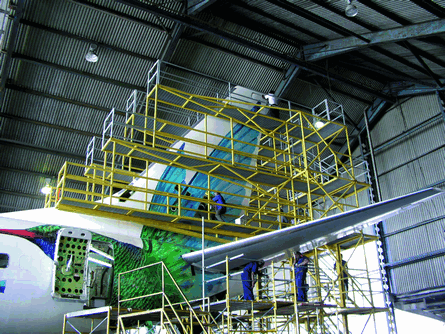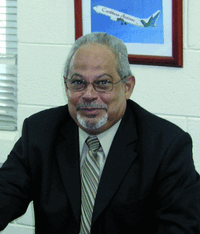Captain Ian Brunton, executive vice-president operations at Caribbean Airlines, has got one important figure on his mind: $500,000. That is the princely sum, on average, that his airline will save in labour costs alone on each Boeing 737-800 C-check that his maintenance and engineering operation now performs.
Caribbean rolled out the first 737 from its base on the island state of Trinidad and Tobago in late June. "We hadn't done a major check in one of those hangars for seven years," explains Brunton. At that time, the work was carried out by BWIA West Indies Airways, which withdrew from performing these two-to-three week checks, preferring instead to outsource the work to Delta TechOps in the USA. BWIA was closed at the end of 2006 and new carrier Caribbean Airlines took to the skies from January 2007.
"Over the years the engineering division had been starved of investment, and then the decision was taken to outsource the heavy checks," says Brunton. It was also felt, in line with conventional industry wisdom, that a carrier operating just a handful of narrowbodies could not have the economies of scale to run a cost-effective servicing operation.
 |
|---|
© Caribbean Airlines |
But the launch of Caribbean from the ashes of BWIA provided the ideal opportunity for management to revisit the decision to outsource its maintenance. The department had also grown when Caribbean brought regional operator Tobago Express into the fold in October 2007. This saw it adding five Bombardier Dash 8-300s to the fleet.
CHANGE MANAGEMENT
During this period management was putting every process in the company under the efficiency microscope in a change management programme facilitated by UK-based consultancy Catalise. In the maintenance area the choice was between moving to even more outsourcing or bringing it back in-house and adding some third party work at a later stage.
"We could easily have stripped out 100 engineers leaving us just with line maintenance. Our processes and procedures were not supported or automated but we knew that we had good people," says Brunton. He admits to being nervous about the prospect of totally outsourcing Caribbean's maintenance operations. "I believe in keeping control - you can't have responsibility without control," he says.
"I argued very strongly that there was economic merit in moving back into C-checks," says Brunton. A crucial factor in his favour is the highly competitive labour rates on the island, which are about a third of those in the USA. And with the labour cost of a C-check representing about three-quarters of the total bill the opportunity was worth exploring.
However, cheaper labour alone would not do the trick. Caribbean knew it had to completely revamp its engineering operation. "We'd done the calculations and we had a number over which engineering could not go," says Peter Davies, who was chief executive at the time. "We were under no pressure to keep an engineering division, it was purely a decision that the airline could make in its own best interests," he says.
It was at this stage that Caribbean began talking to Boeing's Commercial Aviation Services about its challenge. "We learned of their desire to re-engineer the airline and that it was asking whether a small carrier could make sense out of doing MRO in-house," says Michael Sandifer, an executive in Boeing's Customer Solutions group.
This group acts as a consultant to carriers to diagnose their operations and prescribe appropriate changes to processes and procedures as well as products and services targeted to resolve the root cause of their current challenges. At Caribbean the brief went further as Boeing was involved from the start in helping to define the new maintenance organisation and implement the tools to help it function. "It is the most comprehensive project we have done to date," says Sandifer. "We got in at the right time and Caribbean bought into the entire methodology. We have looked at the whole maintenance and engineering operation from end-to-end."
 |
|---|
"We are under budget every month and we've cut down our A-checks from two days to one day"Ian BruntonExecutive VP operations, Caribbean Airlines |
Boeing used what it calls its "Lean-Plus Consulting Methodology" on the Caribbean project. It is essentially an "accelerated methodology to facilitate an airline to go through all this thinking, firstly to identify the symptoms of what is wrong with the current operation, and then map to a future 'to-be' state", says Sandifer.
THE RIGHT TOOLS
The process uses a variety of Boeing's own software tools along the way. "We have developed a number of tools during our work observing the best practices of airlines," says Sandifer. "We consolidated them into this methodology which really does speed up the process. It is a good alternative to hiring a consultant who doesn't know the business."
The starting place is the current functional organisation chart for the carrier's maintenance operation. Every manager is reduced to a single box on the chart representing their functional responsibility. Using Boeing's template for Maintenance & Engineering Value Streams, existing processes are mapped as are the information and skill resources involved and how long each process step takes.
"It is a very deliberate methodology," says Sandifer. "From it you see the bottlenecks. You see islands of activity that are not working. At that level you identify what the key activities performed in each function really are and you start to have a very different view of what the maintenance and engineering division looks like. Identifying the key performance metrics with appropriate targets and goals enables each process cell to become self improving.
"Then you associate people with the functions," says Sandifer. "At Caribbean it ended up being an eye-opening event. We found duplicated efforts between different operational groups - these were all consolidated."
"We got all our subject experts around the table," says Brunton. This was initially done with the company's change management programme office managed by Catalise, with Boeing brought in as the maintenance project got underway. "The biggest challenge was to get managers into it," says Brunton. "They are always too busy getting aircraft out of the door, but we stressed that the project was all about change management."
"One of the key things we looked at was the ratio of employees to airplanes," says Boeing's Sandifer. "We found it had a high ratio compared to peer airlines on all counts. That was illuminating, but in itself doesn't give any answers. What doesn't work is simply to just to pare off 20% of people. What you must do is systematically identify waste and inefficiency in an effort to associate this move with capacity improvements. The question you are continually asking is how to get the maintenance operation much more efficient, and then with these changes ask if it can take on more work. The result should be a transition to a much leaner organisation."
Together Boeing and Caribbean drew up the new structure for the organisation. "We mapped out a future state that sees it moving to a paperless, highly automated, very lean future," says Sandifer. "The project sees it getting back in line with the right headcount to airplane ratios and empowering people to work more efficiently."
An important element of the transformation is developing a single information and control system across the division. "You can't underestimate the benefits of an integrated IT infrastructure, and it doesn't have to cost a fortune," says Sandifer. "The key thing is that pieces of that information can even be outsourced and it becomes a service you subscribe to." According to Brunton: "As we did the work we began to realise that we could actually not only save money, but we could also perform third party work. We benchmarked ourselves with others around the region, such as Aeroman in El Salvador and Copesa in Panama, but it always came out that we could do it cheaper ourselves."
Since putting the new structure in place earlier this year, Caribbean has been seeing the benefits. "We are under budget every month and we've cut down our A-checks from two days to one day," says Brunton. The 737 that finished its C-check in June was the first aircraft Caribbean has worked on at this level under its new regime. "It came out of the shop on time - our previous experience with C-checks when we outsourced them only saw one in 24 shop visits being on time. It was very disappointing," he adds.
Caribbean plans to do four to five C-checks a year with the cost ranging from $700,000 to $1 million depending on the condition of the aircraft and whether special corrosion prevention checks need to be performed on its fleet of seven 737s, says Brunton.
The maintenance operation has gone from a headcount of around 230 people looking after seven 737s to one of 205 staff performing A and C-checks on the Boeings and the five Dash 8s. Caribbean in also working with the Aviation School in Guyana to bring in 18 of its students as apprentices and will be starting its own apprenticeship scheme next year, Brunton explains.
Once it has three or four 737 C-checks "under its belt" the airline will begin seeking third party work. "This could be in about another year or so," says Brunton, who will not be rushed. He is being careful to deliver on promises made to the board. "We knew there were risks and that the board was looking very hard at whether there were overruns on the C-check," says Brunton. So far those risks are being managed.
According to Davies, the move is paying off. "It has been a major investment, but the outcome is a more efficient total operation. It is a classic case of where a small airline can actually make a name for itself for thinking outside the box."
Philip Saunders was interviewed at this year's IATA AGM by Peter Davies, watch the video at: flightglobal.com/ceointerviews
Source: Airline Business



















